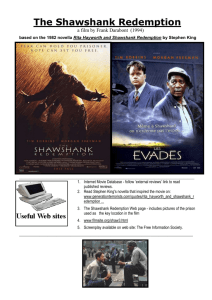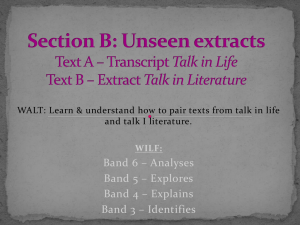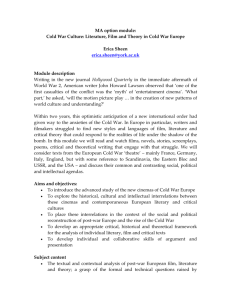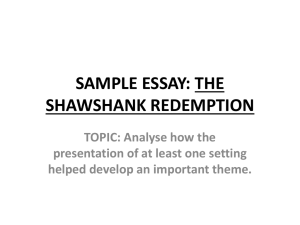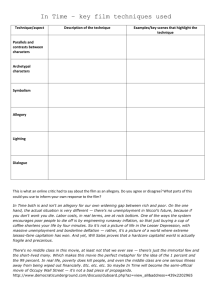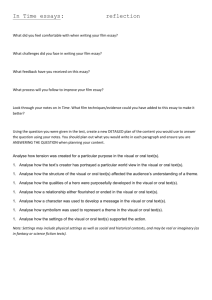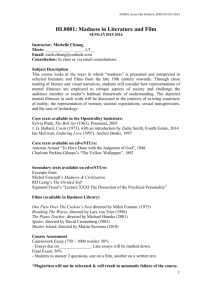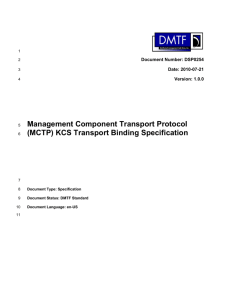The Shawshank Redemption
advertisement
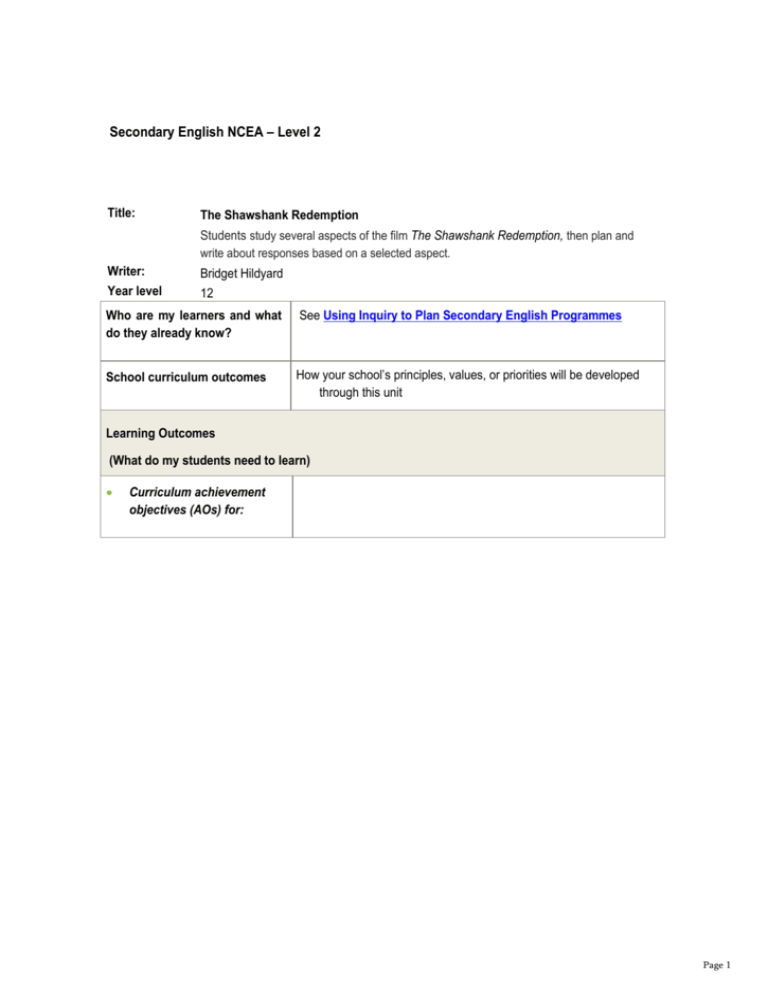
Secondary English NCEA – Level 2 Title: The Shawshank Redemption Students study several aspects of the film The Shawshank Redemption, then plan and write about responses based on a selected aspect. Writer: Bridget Hildyard Year level 12 Who are my learners and what do they already know? See Using Inquiry to Plan Secondary English Programmes School curriculum outcomes How your school’s principles, values, or priorities will be developed through this unit Learning Outcomes (What do my students need to learn) Curriculum achievement objectives (AOs) for: Page 1 English Processes and strategies Integrate sources of information, processes, and strategies purposefully, confidently, and precisely to identify, form, and express increasingly sophisticated ideas. thinks critically about texts with understanding and confidence creates a range of increasingly coherent, varied, and complex texts by integrating sources of information and processing strategies Ideas Select, develop, and communicate sustained ideas on a range of topics. develops, communicates, and sustains increasingly sophisticated ideas, information, and understandings Language features Select and integrate a range of language features appropriately for a variety of effects. uses a wide range of text conventions, including grammatical and spelling conventions, appropriately, effectively, and with accuracy. Structure Organise texts, using a range of appropriate, coherent, and effective structures. organises and develops ideas and information for a particular purpose or effect, using the characteristics and conventions of a range of text forms with control. Page 2 ● Achievement Standard(s) aligned to AO(s) In 2011: 90376: Produce crafted and developed formal transactional writing 90379: Analyse a visual or oral text From 2012: 2.4 Produce a selection of crafted and controlled writing . 2.2 Analyse specified aspect(s) of studied visual or oral text(s), with supporting evidence Teaching and Learning (What do I need to know and do?) 1-2 related professional readings or links to relevant research Effective Practices in Teaching Writing in NZ Secondary Schools [available from February 2011] Using inquiry to plan secondary English programmes English Teaching and Learning Guide [available from February 2011] Conditions of Assessment Guidelines Page 3 Learning task 1 Learning task 1 Learning intention(s) Establishing prior learning and linking it to the text KCs/ Principles/Val ues focus Pre viewing 1. Look at the title of the film. What does it suggest? What is redemption? KCs: Thinking Redemption (n) - The act of redeeming. Redeeming (adj) - Serving to compensate for – explore texts faults or deficiencies. Relate to others – peer discussion Redeem (vb) - 1. To recover possession of by payment of a price or service. 2. To convert (bonds or shares) into cash. 3. To pay off (a loan or debt). 4. To recover (something mortgaged or pawned). 5. To exchange(coupons) for goods. 6. To fulfil (a promise) 7. To reinstate someone's good opinion. 8. To make amends for. 9. To recover from captivity, esp. by a money payment. Taken from, The Collins Pocket Dictionary, HarperCollins Publishers, England, 1989. 2. Given that ‘Shawshank’ is the name of a fictional prison, what predictions can you make about the film based on the title ‘Shawshank Redemption'? Viewing 3. Use the viewing worksheet to complete responses to the film. Complete these questions as you are watching the film in the final 10 minutes of each viewing period. 4. Discuss answers/ideas as a class. It can be a group activity, ie. each group takes a question and then reports back. 5. Write a personal response to the film. Use such starters as, 'I enjoyed the film because...', 'I especially liked the scene where...', 'The character that remained in my mind was... because...', etc. Page 4 Learning task 2 Learning task 2 Learning intention(s) Theme and character Examining key text aspects Home and Expert Groups – Exploring Themes KCs/ KCs: Thinking Principles/Va –using a range lues focus of thinking strategies to build understandings KCs: Thinking – explore texts Relate to others – peer discussion 1. Divide the class into as many groups as there are in each group; for example, 5 groups of 5. These are the expert groups and each group will have one question to discuss (see below) so that they can then share ideas in detail. After discussing one question per expert group, new home groups are formed with one person from each of the expert groups. Each person in their home group must share their ideas on the one question they discussed in their expert group, so that everyone in their home group hears about each question. Expert Group Questions: Explain the meaning of institutionalised. How does it apply to Brooks? What aspect(s) of prison life are emphasised throughout the movie? Give examples. Why does the Pacific Ocean have such appeal to Andy? How do all the prisoners accept one another’s crimes in the prison? How is this significant? List some examples of corruption of the legal process and the corrections process in the movie. In what respects is justice finally achieved in the movie? 2. Following the home and expert group activity, in your home groups talk about the main issues or themes raised in this film. Your discussions might touch on some of the following themes: Courage Loyalty The power of the mind vs the power of authority Institutionalisation Corruption Page 5 Justice/injustice Learning task 3 Learning task 3 Learning intention(s) Examining key text aspects Film techniques 1. Talk about the film terms resource. 2. Look at how the setting is conveyed. View the 'introduction to Shawshank' scene where we first see the prison. How is the prison made to appear large, imposing KCs/ Principles/Val ues focus KCs: Thinking and bleak? Look particularly at the shot selection, colour – close reading and music: Crane shot shows us the prison from a bird’s eye view, sweeping views establish and emphasise the prison's size. The music is slow, played by strings and has a deep drawn out bass which adds to the feeling that this is a place of sadness. The colours are bleak. Prisoner's uniforms are grey (as is the sky) and the lighting is dull. We see the prison through Andy's eyes as he enters. Moves from a low angle of the entrance to an undershot which gives the impression that he is entering a place of misery and will not emerge for a long time. Again the sheer size of the place is shown in an imposing way. Inside the prison it is dark, lit only by natural light from the windows. This creates long shadows which give an eerie, cold feeling and we get the suspicion that all is not as it should be, shadows hide secrets. Close viewing 3. View the following scenes again and talk about the related questions: What shot is used when Andy is given his sentence by the judge? Explain the intended effect. A point of view shot is used when we view a scene through a character's eyes. Identify and explain the effect at least two point of view shots used during the prisoners' arrival scene. What angle is used when Andy is about to be Page 6 Learning task 4 Learning task 4 Learning intention(s) Drafting and polishing writing. KCs/ Principles/ Values focus KCs: Use language, symbols and texts – structure and express understandings about texts Developing a piece of formal writing 1. Develop a piece of formal writing on a topic linked to an aspect of learning tasks 2 or 3. In selecting a topic, it is vital that you select one suited to this text and to your understandings about it. As a first step in choosing a topic, consider the topics set for the externally assessed standard 90379 Analyse a visual or oral text. Talk with your teacher about the most appropriate topic for the learning completed in tasks 2 and 3. In selecting a topic, give preference to a topic in an paper from the last few years. 2. This writing can be included as part of your folio. In 2011, it can be assessed during your class programme against Achievement Standard 90376: Produce crafted and developed formal transactional writing. From 2012, it can be assessed against its replacement, the new Level 2 writing standard, AS 2.4 Produce a selection of crafted and controlled writing. The same standard of writing is required at each achievement level for both the old and new achievement standards. 3. At the end of 2011, your writing can also become part of preparing for the externally assessed AS 90379 Analyse a visual or oral text. In 2012, this standard is replaced by AS 2.2 Analyse specified aspect(s) of studied visual or oral text(s), with supporting evidence. Both these standards assess comparable outcomes: analyse specified aspect(s) of studied visual or oral text(s), with supporting evidence. 4. Look at to the assessment schedule and the relevant exemplars. These are for AS 90379 and were written under exam conditions. Note that the achievement exemplar [The Piano] requires attention to style, syntax and text conventions before it would meet the second criterion [craft controlled writing] for the new AS 2.4 [and AS 90376]. However, it provides an indication of the level required to meet the first AS 2.4 criterion [develop, sustain and structure ideas]. The merit [Alive] and excellence [Into the Wild] exemplars meet all criteria for the writing standards. Additional exemplars are available for this achievement standard by ordering the NZATE exemplar resource. 5. Look over the Assessment Reports for AS 90379. An excellence level response: includes a stated hypothesis in the introduction which was developed and referred back to throughout the response Page 7 Assessment and Evaluation (What is the impact of my teaching and learning?) Formative and/or Summative assessment task(s), including how will feedback be provided In 2011: 90376: Produce crafted and developed formal transactional writing 90379: Analyse a visual or oral text From 2012: 2.4 Produce a selection of crafted and controlled writing. 2.2 Analyse specified aspect(s) of studied visual or oral text(s), with supporting evidence Provision for identifying next learning steps for students who need: This piece of writing should be an integrated part of the year’s writing programme. Refer to - further learning opportunities English Teaching and Learning Guide [available from February 2011] - increased challenge Conditions of Assessment Guidelines for formal writing Effective Practices in Teaching Writing in NZ Secondary Schools [available from February 2011] for more details. Tools or ideas which, for example See: Using inquiry to plan secondary English programmes might be used to evaluate: - progress of the class and groups within it - student engagement leading to : - changes to the sequence - addressing teacher learning needs Page 8
